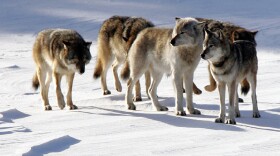All this week, we’re visiting an island archipelago in Lake Superior. Isle Royale National Park is so remote you can only get here by ferry or seaplane. It's mostly wilderness. Cell phones don’t work here.
Wolves and moose have the run of the island. It’s an ideal place for people who study the big mammals.
"A nine month old calf. It looks like it might’ve just fallen down the rocky edge and never got up."
Rolf Peterson has come across a moose skeleton. Mourning cloak butterflies are lapping up sodium from the bones. With a yank and a twist, Peterson rips off the skull.
"I think it’s least disruptive if we just saw off the back leg."
Every bone tells a story. Peterson can tell how the moose lived and how it died. He can tell whether it fell and broke its ribs, whether it starved or was killed by wolves.
"We look for any abnormalities in any of the bones. And particularly, how big it was, what its early developmental history and nutritional history was, which is key to its adult health."
Over the past 54 years, researchers have collected more than 4,ooo moose skeletons on the island. The bones offer clues about the moose population – and about the wolves. Wolves got here by crossing an ice bridge from Ontario in the late 1940’s.
This study of wolves and moose is the longest running study in the world of a predator and its prey. Rolf Peterson has been involved for 42 years of the study. He’s been here through the brutal black fly summers and the harshest winters. He and his wife Candy live in an old fishing cabin on the island for much of the year.
Wolves are secretive on the island. Candy Peterson says it’s unusual to see them.
"It’s really much more fun to hear them because you can hear them without their knowing you’re listening. That mournful, lonely howl, it does really send shivers up and down your back."
Rolf Peterson and other scientists spend the winters flying over the island in a little two seat plane. They watch – and count – the wolves and moose from the air.
Over the years, they’ve seen the wolf and moose populations boom and crash. This past winter, the wolf population dropped from 16 wolves down to its lowest point ever: just nine.
"A lot of it was due to high mortality that we don’t even know the cause of. That’s a big red flag. There are apparently two females. So two out of nine, they’re just hanging by their teeth, so, high, high risk of extinction."
He says there could be a few reasons why the wolf population has been sinking over the past six years. The wolves are highly inbred, and Peterson says it’s unlikely that new wolves will come here on their own, because fewer ice bridges are forming in our warmer climate. There’s a shortage of the old moose that wolves like to eat. And a fatal disease called canine parvovirus could be hurting the wolves.
If the wolves die off, it will be up to the National Park Service to decide whether or not to re-introduce wolves to Isle Royale.
Long term studies like these are extremely rare. Rolf Peterson says there are all kinds of hurdles: financial, logistic, political.
But he says studies that last this long give us a more complete picture of how nature works.
"The answers that you get after 10 or 20 or 30 or 50 years are entirely different from what they would've been after five years. I mean, sometimes you get the opposite conclusion. So that makes you very cautious about saying what we know for sure."



































